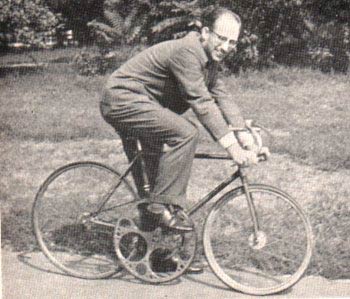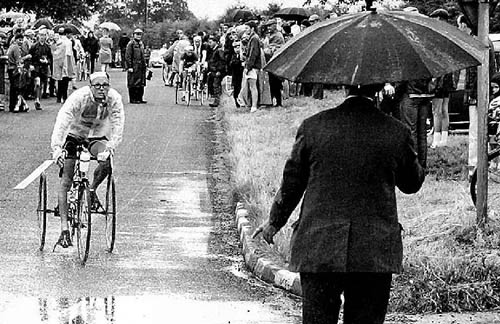We’d like to remind Forumites to please avoid political debate on the Forum.
This is to keep it a safe and useful space for MoneySaving discussions. Threads that are – or become – political in nature may be removed in line with the Forum’s rules. Thank you for your understanding.
📨 Have you signed up to the Forum's new Email Digest yet? Get a selection of trending threads sent straight to your inbox daily, weekly or monthly!
Bicycle Gears?
Comments
-
I agree, hub gears are a lot better! However for a 21-speed MTB, the range will likely be greater than any 8-gear hub. That said, some of those 21 gears will not be usable and some will be duplicated, while yours will be unique. However I have a 14-gear hub and it's brilliantcardinalbiggles wrote: »I have an 8 speed hub, wouldnt go back! No gear overlap no crunching and dodgy changes and best of all no maintainance! I often overtake people faffing about with gears, and several of my friends end up with gear problems on bike rides, while I never have such problems. 0
I often overtake people faffing about with gears, and several of my friends end up with gear problems on bike rides, while I never have such problems. 0 -
I agree, hub gears are a lot better! However for a 21-speed MTB, the range will likely be greater than any 8-gear hub. That said, some of those 21 gears will not be usable and some will be duplicated, while yours will be unique. However I have a 14-gear hub and it's brilliant

And so it should be at £1000.I often overtake people faffing about with gears, and several of my friends end up with gear problems on bike rides, while I never have such problems.
Are said friends using derailleur systems of comparable cost; i.e. SRAM Red, Shimano Duraace, etc.?0 -
OK a bike has 21 gears.
The front "GEAR A" has three cogs, small, medium and large
THe rear "GEAR B" has 7 cogs.
Now how these work. If you go up hill its hard to pedal so you have to change gear, but what is the general rules for the gear changing.
Do most people use gears or do you tend to just peddle on the same gear.
Another bike might have 20 gears:
front chainset with two chainrings
rear cassette with 10 cogs
That is a much better setup.
Forget the 21gear nonsense, basically 7-speed rear derailleurs/cassettes are bottom-of-the-range, 8-speed are low-end, 9-speed tends to be better, high-end is 10-speed and above that 11-speed.
Gearing is pretty simple - the basic rule is front gear teeth divided by back gear teeth gives the mechanical advantage, which indicates speed but also how much effort to pedal.
A typical cheap 21-speed consists of a cassette at the back with:
14,16,18,20,22,24,34 teeth cogs
and then at the front
28,38,48 cogs
The fastest speed is given using the most teeth at the front and the fewest at the back - in this case 48/14 is a 3.42 ratio.
And the lowest is the 28/34 = 0.82 ratio.
Your speed is then determined by the bike's wheel size, the gear ratio, and the cadence (rpm) of your pedalling. In the top gear 48/14 on a 26"-wheeled bike you will be doing 15.9mph at 60rpm. On a road bike with larger wheels, that would be 16.7mph.
In that bottom gear, you would be doing only 3.8mph at 60rpm.
The issue with having three chainrings is that front gears are stacked smallest on the bottom and the rear smallest on the top. It's most efficient if the gear selected at front and at back is roughly parallel, if it's not you will have additional wear to your bike drivetrain components. This means that if you have the biggest gear selected at the front you will want to be in one of the smallest at the back, in the middle gear one of the middle gears at the back, and in the smallest gear at the front a big gear at the back - all in order to keep the chain nicely aligned.
In reality then your '21 gears' are nothing of the kind - you will probably use something like
48/14 = 3.43 (gear 3/7)
48/16 = 3 (gear 3/6)
48/18 = 2.67 (gear 3/5)
38/14 = 2.71 (gear 2/7)
38/16 = 2.38 (gear 2/6)
38/18 = 2.11 (gear 2/5)
38/20 = 1.9 (gear 2/4)
38/22 = 1.73 (gear 2/3)
38/24 = 1.58 (gear 2/2)
28/20 = 1.4 (gear 1/4)
28/22 = 1.27 (gear 1/3)
28/24 = 1.17 (gear 1/2)
28/34 = 0.82 (gear 1/1)
Note that 3/5 is nearly the same as 2/7, so you have about 12 useful gears. In this case your gear range from largest to smallest is 418%.
With a hub gear all the gears are enclosed internally and the gears are all real useable gears. With a 3 or 4 speed hub gear (cheap and low maintenance) you only get about 180% range, which makes 3-speed bikes good for going on flat roads to the shops, but less than ideal for touring, since you're either going to be missing the top (faster) or bottom (slower, steeper) of the range.
7 and 8-speed hub gears run about the same as a half-decent derailleur setup but the range is less at about 300%, but expensive 11 and 14-speed hubs have ranges of over 400% and 500% making them as good as wide-range derailleur setups in terms of gear ranges.
It's important to change gear regularly - before you climb up a hill you should change down (trying to change while under load, climbing, will cause damage to the parts), and when descending you will want to use the biggest gear possible for maximum speed. If you are using the top gear all the time you either have very low gearing, or more likely you are pedalling too slowly, for normal use on the flat you should be pedalling at higher cadence but with less resistance, leaving higher gears free for downhills and for when you need extra speed.0 -
I think you are meant to stop pedalling just for a sec as you change gear , makes for a smoother change...
that depends on the quality of the gearset and how well its set up
for a decent set up you can shift while pedalling unless you are doing the likes of a steep hill in high gears0 -
I used to be a road racing cyclist many years ago but we had 10 gears even in those days. I'll be repeating some things that have already been said but here goes:
1. don't think about progressing up and down the gears using all of them and avoid the extreme ones e.g largest chainwheel/smallest sprocket as they are unkind to the chain.
2. for general purpose riding on level roads use a gear somewhere in the middle of the range and aim to pedal fairly fast - as someone has said, about 60 rpm.is good. Don't slog along in a high gear - it's very tiring.
3. to change gear take pressure off the pedals but keep on rotating them.
4. when approaching a hill change down early.
4. hub gears are far less sensitive to dirt and water and make a lot of sense except for competition use as they weigh more and offer fewer ratios.0 -
2. for general purpose riding on level roads use a gear somewhere in the middle of the range and aim to pedal fairly fast - as someone has said, about 60 rpm.is good. Don't slog along in a high gear - it's very tiring.
60rpm is a little on the slow side, up towards 80 is optimal, but 60 is probably ok for novices.4. hub gears are far less sensitive to dirt and water and make a lot of sense except for competition use as they weigh more and offer fewer ratios.
A Rohloff with cables and shifter weighs 1820 grams, which is only slightly heavier than a comparable derailleur setup - the real difference is that most of the weight is at the back of the bike, whereas derailleurs are more balanced. The range and number of usable gears is comparable to a derailleur setup with high-end hub gears
A Rohloff 14 speed setup is £900, a Shimano Alfine 11 £400 and a Shimano Alfine 8 is £200. Halfords do an Alfine 8 bike for £400, pre-built Alfine 11 are £1000+ and the Rohloff £2k+.0 -
I should perhaps mention the old [maybe still current] notation for bicycle gearing. You quote the effective diameter of the back wheel by taking its actual diameter [often 26 or 27 inches but probably metric now] and multiply by the ratio of tooth numbers on the chainwheel to tooth numbers on the sprocket. Thus 48T chainwheel, 16T sprocket - ratio is 3 so for a 27 inch wheel that's 81 inches. Overall gearing spread for a road bike is [or used to be] around 48 to 104 inches, for normal level road use try 68-72 inches.0
-
My uncle stan died when he rode into a parked lorry whilst doing 78 mph,
be careful out there everyone !
some nice old racing pics here.
http://cyclinginfo.co.uk/blog/timetrials/classic-time-trial-photos/
Norman Maggs smokes a pipe during a 24 hour time trial.0 -
-
That bike with the very big chainwheel must have been used for motor-paced racing. Note the backward turned front forks to get the rider a few inches closer to the shield on the motor. I can't imagine what that did to the steering - must have been very unstable i.e. the opposite of self-centring.0
This discussion has been closed.
Confirm your email address to Create Threads and Reply

Categories
- All Categories
- 352.2K Banking & Borrowing
- 253.6K Reduce Debt & Boost Income
- 454.3K Spending & Discounts
- 245.2K Work, Benefits & Business
- 600.9K Mortgages, Homes & Bills
- 177.5K Life & Family
- 259K Travel & Transport
- 1.5M Hobbies & Leisure
- 16K Discuss & Feedback
- 37.7K Read-Only Boards



